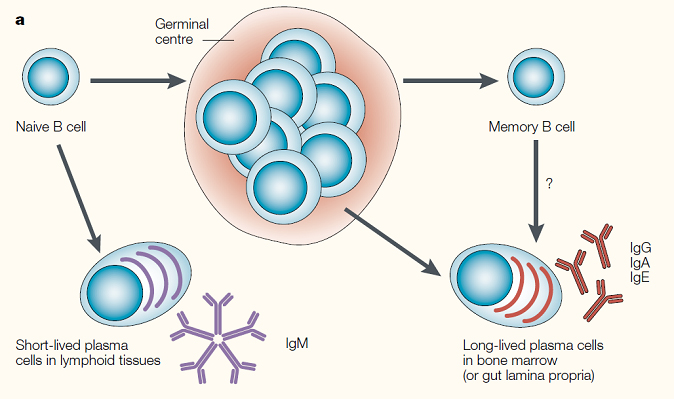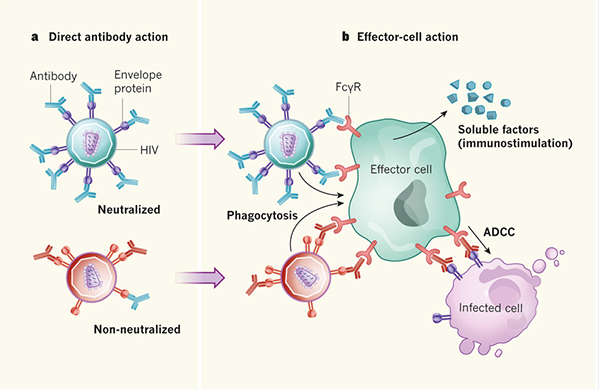B Cell Activation and Effector Functions
B Cell Activation and Isotype Switching
- B cells are activated by antigen presented by MHC and co-stimulatory (CD40-CD40L) signals from Th2 cells.
- After activation, B cells undergo rounds of mutation and selection to generate high-affinity memory B cells and plasma cells.
- Plasma cells are B cells that secrete their antigen-specific receptors in the form of antibodies.

Used with permission from Macmillan Publishers Ltd: Nature Reviews Immunology 2, 60-65, copyright 2002.
- B cells are similar to T cells in that they undergo somatic hypermutation to produce their antigen receptors. However, B cells also undergo a process called isotype switching which allows different functional classes of antibodies (i.e., IgM and IgG) to be produced that all have the same antigen specificity.
- Isotypedetermines the effector function of the antibody.
- Antibodies are originally of the IgM isotype.
- When activated B cells are exposed to IL-4, they undergo isotype switching to IgE.
- When activated B cells are exposed to TGF-beta, they undergo isotype switching to IgG2b and IgA.
- When activated B cells are exposed to IFN-gamma, they undergo isotype switching to IgG2a and IgG3.
Antibody Effector Functions
- Antibodies bind to extracellular pathogens and toxins to mediate their destruction by phagocytic cells.
- There are 4 main methods by which antibodies exert their effects

Used with permission from Macmillan Publishers Ltd: Nature 421, 440-444, copyright 2003.
- Neutralization occurs when antibodies bind to pathogens or toxins in order to prevent the pathogens from infecting cells.
- Opsonization
- Antibodies contain both a Fab region, which is specific for the antigen, and an Fc region, or constant region. When a bacterium or toxin is covered with antibodies, the Fc region of these antibodies can be recognized by phagocytic cells during the process of opsonization.
- Note: This is one of the main effector mechanisms responsible for the efficacy of anti-CD20 and anti-CD52 monoclonal antibodies. When these antibodies bind to cancer cells expressing CD20 or CD52, they induce opsonization, which leads to the death of the cancer cells.
- Complement Activation
- Complement is a system of plasma proteins that can be activated by antibodies bound on a cell. The complement cascade leads to the formation of a protein complex on bacteria that can kill the bacteria. The complement system can also activate phagocytes to destroy bacteria that would otherwise not be recognized by the immune system.
- Antibody-Dependent Cellular Cytotoxicity (ADCC)
- ADCC occurs when the Fc portion of an antibody bound to the surface of a cell interacts with Fc receptor on immune cells such as macrophages, NK cells and neutrophils. This triggers the immune cell to target the antibody-coated cell for lysis.


